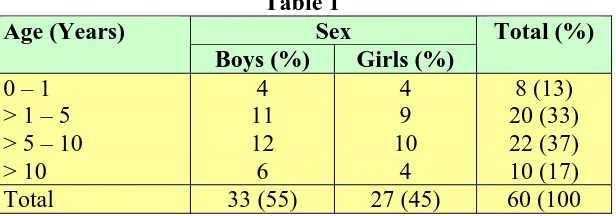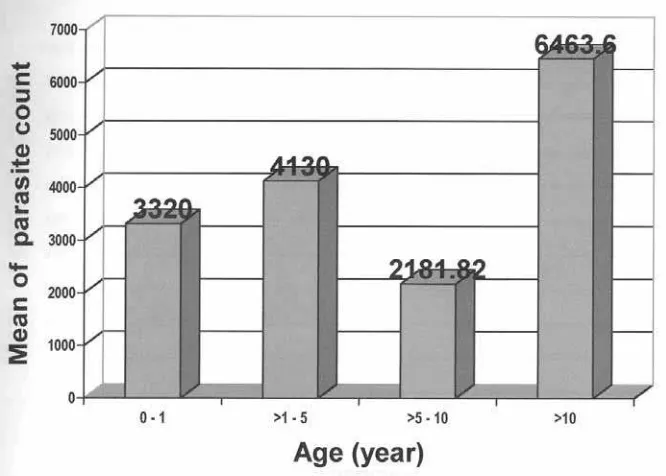The Correction Between Parasitemia And
Spleen Size In Children With Falciparum Malaria
Syahril Pasaribu Chairuddin P. Lubis
Department Of Child Health Medical School
University of Sumatera Utara.
Objective : To find out the correlation between parasitemia and spleen size in falciparum malaria children.
Methods : The study was conducted in 5 villages in the district of Mandailing Natal, North Sumatera Province, Indonesia. Subjects were children who visited to the Health Center with the complaints of fever, shivering, pale, jaundice, diarrhea and headache. Diagnosis was made by using thin and thick blood smear of Giemsa's method and Hackett's method was done as a tool for spleen size. Data had been analyzed by ANOVA (SPSS Version 10.5).
Results : From 152 patients, 60 (39.5%) was falciparum malaria, 83 (54.5%) was vivax malaria and 9 (6.0%) was mixed infection (plasmodium falciparum + plasmodium vivax). The youngest patient of falciparum malaria was 6 month old. Splenomegaly had been found in 27 cases, Hackett 1 in 9 (33.3%) ; Hackett 2 in 11 (40.7%) cases and Hackett 3 in 7 (26.0%) cases. Mean parasites count in splenomegaly patients were higher than normal spleen size patients. We found that the correlation between parasitemia and spleen size, especially there was significant correlation between Ho and H3.
Conclusion : There was correlation between parasitemia and spleen size in children with falciparum malaria.
Key words : falciparum malaria, parasitemia, splenomegaly
Introduction
Malaria is a life-threatening parasitic disease transmitted by mosquitoes. Today approximately 40% of the world's population, mostly those living in the world's poorest countries is a risk of malaria. The disease was once more widespread but it was successfully eliminated from many countries with temperate climates during the mid 20th century. Today malaria is found throughout the tropical and sub-tropical regions of the world and causes more than 300 million acute illnesses at least one million deaths annually 1.
There is a semi-quantitative relationship between the magnitude of the parasitemia and the risk of death, especially among non-immune expatriates with Plamodium falciparum infection. Parasites in blood more than 100.000/microlitre were associated with severe infection3.
Spleen is an important organ in immunity to malaria infection. As the body's largest lymphoid organ, the spleen has a variety of immunology functions, such as sieve for the blood, removing blood cells, microorganisms and immune complexes. Red blood cells (RBC) that contain inclusions, after circulating through the splenic micro-vasculature, may be returned to the blood stream after remodeling (pitting)4. Taylor had written about the increasing of antibody titer and level of Immunoglobulin M in chronic malaria with massive splenomegaly5. The spleen was always affected in person suffered from malaria. The palpable spleen is one of the main clinical symptoms. History of fever, anemia and splenomegaly are predicting symptoms for clinical diagnosis of malaria infection in endemic area6. The spleen is enlarged in a first attack or after several attacks in a duration of time7 Red blood cells that contain merozoites will induced humoral and cellular immune responses, results in phagocytic effect towards the parasites infected cells, pigment and remain cells of histiocytes and macrophages from reticulo-endothelial, particularly spleen8. The main changes were congestion, but later spleen becomes dark result from the accumulation of pigment in parasitized cells in the capillaries and loci of necrosis in the splenic pulp 6,9.
The objective of this study is to describe the correlation between parasitemia and spleen size in falciparum malaria children.
Materials and Methods
A cross sectional study was conducted in 5 villages, Mandailing-Natal (Madina) District, North Sumatera Province, Indonesia during the period of April 9th - 19th , 2001. The inclusion criteria were fever, pale, diarrhea, headache and jaundice. Patients who had got anti-malarial drugs one week before study were excluded.
Blood examination for counting the parasites was performed by taking a drop of blood from finger or toe in infants. Thick blood smear was used for detecting parasites and thin blood smear for identification of malaria parasites. The spleen enlargement was determined by Hackett'& method6 :
Class of Spleen Description
0
Normal spleen not palpable even in deep inspiration .
Spleen palpable below the costal margin usually on deep inspiration. Spleen palpable below the costal margin, but not projected beyond a horizontal line half way between the costal margin and the umbilicus measured along a line dropped vertically from left nipple.
Spleen with lowest palpable point projected more than half way to the umbilicus but not below a line drawn horizontally through it.
Spleen with lowest palpable point below the umbilical level but not projected beyond a horizontal line situated half way between the umbilicus and the symphysis pubis.
Data was analyzed by using the computer program of SPSS version 10.5 Correlation between parasitemia and spleen size was assesed by ANOVA.
Results
From 152 patients, 60 (39.5%) was falciparum malaria, 83 (54.5%) was vivax malaria and 9 (6.0%) was mixed infection (Plasmodium falciparum with Plasmodium vivax). Sixty patients were enrolled in this study The youngest patient was 6 month old and the oldest was 13 year old. There were 33 (55%) boys and 27 (45%) girls. The highest proportion was the age group of > 5 - 10 year old (37%) (table 1).
From history, the most clinical symptoms were fever (97%), pale (80%), headache (55%), diarrhea (42%), and jaundice (13%) respectively. On physical examination we found that 27 patients had splenomegaly.
The mean parasitemia was highest in the age group of > 10 years old (6463.60 + 10.662.23), but statistical analysis showed no significant correlation between mean parasite count and age groups (figure 1)
Figure 1. The correlation of mean parasite count with age groups
The mean parasite count in patients with splenomegaly was higher than without splenomegaly. There was clinically different in mean parasite count between H0, H1, H2 and H3. There was significant correlation in mean parasite count between Ho and H3 (figure 2).
Discussion
We found that there was splenomegaly in 27 patients (45%). This result as same as Annobil in Saudi Arabia 10. Hepatomegaly was found only in 10 cases (17%). Sowunmi found that hepatomegaly was more common than splenomegaly and was significantly more frequent in younger than in older children. He found that there was no correlation between liver and parasite densit11. In our study, 9 of 10 malaria cases with hepatomegaly less than 5 year old, and parasite rate around 120 - 14.800/µL. During the acute infection, Kupffer cells may increase in both number and size. They contain hemozoin, parasites, parasitized and unparasitized erythrocytes 5,6.
In this study, we found that no correlation between mean parasite count and age groups (p>0.05), but in clinically parasitemia will increase according to age groups.
Normal spleen function is an important host factor because of both the immunologic and filtering functions of the spleen. The spleen always affected in malaria.
The palpable enlargement of this organ is one the main clinical symptoms. The main change is that of congestion, but later the spleen becomes dark from the accumulation of pigment in parasitized cells in the capillaries and sinusoid6. Spleen enlargement in malaria related to the lysis of erythrocytes that infected by merozoit, and will induce immune responses include spleen as a part of RES (reticulo-endothelial system), and enlargement of spleen as a consequency 12. From this study we found that there was correlation between mean parasite count and spleen size (p<0.05). Strickland found that children with splenomegaly were 3 times more likely to have Plasmodium falciparum and probability of a child with splenomegaly having a malaria parasitemia was highest. Mean Plasmodium falciparum parasitemias were significantly higher in infected children with moderately enlarged spleens than in infected children with non palpable spleens or in those with minimal or extensive splenomegaly13. Prybylski said that a history of fever, rigors, headache, myalgia, elevated temperature, and a palpable spleen among children were all strongly associated with the presence and density of Plasmodium falciparum malaria 14. But Touze et al found that no significant correlation was observed between parasitemia and the following clinical and biological symptoms: fever, splenomegaly, hemoglobin level and platelet count15.
Conclusion
There was correlation between parasitemia and spleen size in children with falciparum malaria.
References
Roll Back Malaria (RBM). World Health Organization, 1998. Available from URL : http://www.rbm.who.int
Rampengan TH, Laurentz IR. Penyakit infeksi tropis pada anak. Jakarta, EGC,1997:185-204
Lutwick LI. Infections in asplenic patients. In Mandell GL, Benet JE, Dolin Reds. Principles and Practice of Infectious Diseases. New York, Churchill Livingstone, 2000:3169-75
Taylor TE, Strickland GT, Infections of the blood and reticulo-endothelial system. In Strikland GT ed. Hunter's Tropical Medicine and Emerging Infectious Diseases 8th ed. Philadelphia, W.B.Saunders Company, 1999:614-42
Bruce-Chwatt LJ. Essential Malariology, 2nd ed. London, William Heinemann Medical Books Ltd, 1978:72-8
Rita M, Harijani AM, Sustriayu N, Tjitra E. Penelitian Malaria di Kecamatan Teluk Dalam, Nias, Sumatera Utara. Cermin Dunia Kedokteran, 1996 ; 1 06:5-9
Lubis CP. Sera Epidemiologi Malaria. Majalah Kedokteran Nusantara 1990;3: 135-46
Albar H, Agustina IS, Hangewa P, Syamsiah I. Malaria Pada Anak di RSU Ternate. Cermin Dunia Kedokteran 1994;96:28-30
Annobil SH, Okeahialam TC, Jamjoom GA, Bassuni WA. Malaria in Children-Experience Fram Asir Region, Saudi Arabia. Ann Saudi Med 1994;94:467 -70.
Sowunmi A. Hepatomegaly in Acute Falciparum Malaria in Children. Trans R Soc Trap Med Hyg, 1996;90(5):540-2
Pribadi W, Sungkar S. Malaria. Jakarta, Balai Penerbit UI, 1994:7-8.
Strickland GT, Fox E, Hadi H. Malaria and Splenomegaly in the Punjab. Trans R Soc Med Hyg, 1988;82(5):667-70
Prybylski D, Khaliq A, Fox E, Sarwari AR, Strickland GT. Parasite Density and Malaria Morbidity in the Pakistani Punjab. Am J Trop Med Hyg, 1999;61 (5):791-801.

